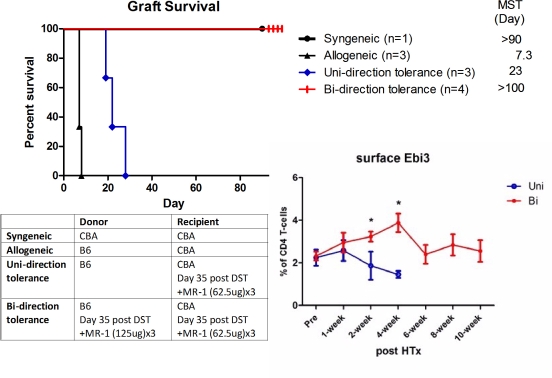The Mark of Zorro: IL35-Coated Exosomes Cross-Dress and Exhaust Recipient T & B Cells during Transplant Tolerance
1Surgery, University of Wisconsin, Madison, WI
2Surgery, Tokyo Women's Hospital, Tokyo, Japan
3Immunology, University of Pittsburgh Medical Center, Pittsburgh, PA.
Meeting: 2018 American Transplant Congress
Abstract number: 264
Session Information
Session Name: Concurrent Session: Novel Regulatory Pathways in Tolerance
Session Type: Concurrent Session
Date: Monday, June 4, 2018
Session Time: 2:30pm-4:00pm
 Presentation Time: 3:18pm-3:30pm
Presentation Time: 3:18pm-3:30pm
Location: Room 606/607
The folk-hero "Zorro" left his mark on by a sword-slashed "Z". In transplant recipients, rare Tregs also leave a mark on their conventional T & B LC targets. This mark is caused by Ag-specific CD4 Tregs that release IL35-coated exosomes, “cross-dressing” (xD) their targets with IL35. Hypotheses: 1) IL35 suppression by passenger Tregs is greatly amplified by xD of host T cells; 2) monitoring CD4+ T cells displaying IL35/xD-phenotype after heterotopic heart transplantation will correlate with biD regulation(HvG and GvH), and 3) that IL-35-induced “exhaustion” is a direct result of the IL35/xD-phenotype. Approach: We tolerized B6 “donor” mice with CBA DST + 125 ug (x3) MR1(anti-CD40L). We sub-optimally tolerized recipient CBA mice with B6 DST + 62.5 ug(x3) injections of MR1. On d.35, the CBA mice received either a normal B6 heart allograft(uni-D regulation) or one from a CBA-tolerized B6 donor(biD regulation).Results: While the uni-D CBA showed prolonged allograft survival, by 4 weeks all grafts were rejected. When the heart from a tolerized B6 mouse was transplanted in the same recipient, all grafts survived long term. There was an initial slight increase in % surface Ebi3+ T-CD4 cells in the uni-D mice, then the % began to drop at 2 wks and was even lower at the time of graft rejection (4 wk). In contrast, the PBMC-CD4 T cell % of IL35-xD cells continued to climb at 2 & 4 wks in the biD group, after which the level stabilized, suggesting an amplified impact of IL35 exosome production from the donor side. Population microscopy, depicting IL35-xD cells showed punctate surface staining of Ebi3 that was similar in CD4 T, CD8 T, and B cell subsets. A similar, but non-identical, pattern of p35 expression was seen in Ebi3- xD cells. Exhaustion was confined to the IL35-xD cells and was absent from non-IL35 xD cells. Conclusion: Tregs produce IL35-coated exosomes. These exosomes left a “mark”, punctate surface IL35 expression, while also promoting exhaustion in T and B cells.
When the heart from a tolerized B6 mouse was transplanted in the same recipient, all grafts survived long term. There was an initial slight increase in % surface Ebi3+ T-CD4 cells in the uni-D mice, then the % began to drop at 2 wks and was even lower at the time of graft rejection (4 wk). In contrast, the PBMC-CD4 T cell % of IL35-xD cells continued to climb at 2 & 4 wks in the biD group, after which the level stabilized, suggesting an amplified impact of IL35 exosome production from the donor side. Population microscopy, depicting IL35-xD cells showed punctate surface staining of Ebi3 that was similar in CD4 T, CD8 T, and B cell subsets. A similar, but non-identical, pattern of p35 expression was seen in Ebi3- xD cells. Exhaustion was confined to the IL35-xD cells and was absent from non-IL35 xD cells. Conclusion: Tregs produce IL35-coated exosomes. These exosomes left a “mark”, punctate surface IL35 expression, while also promoting exhaustion in T and B cells.
CITATION INFORMATION: Burlingham W., Sullivan J., Lema D., Tomita Y., Zhou Y., Vignali D. The Mark of Zorro: IL35-Coated Exosomes Cross-Dress and Exhaust Recipient T & B Cells during Transplant Tolerance Am J Transplant. 2017;17 (suppl 3).
To cite this abstract in AMA style:
Burlingham W, Sullivan J, Lema D, Tomita Y, Zhou Y, Vignali D. The Mark of Zorro: IL35-Coated Exosomes Cross-Dress and Exhaust Recipient T & B Cells during Transplant Tolerance [abstract]. https://atcmeetingabstracts.com/abstract/the-mark-of-zorro-il35-coated-exosomes-cross-dress-and-exhaust-recipient-t-b-cells-during-transplant-tolerance/. Accessed December 14, 2025.« Back to 2018 American Transplant Congress
